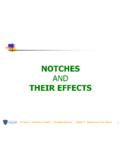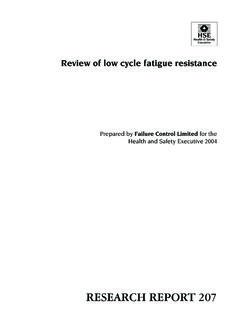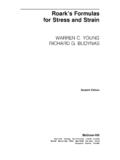Transcription of The Local Stress-Strain Fatigue Method
1 The Local Stress-Strain Fatigue Method ( -N) 2010 Grzegorz Glinka. All rights most engineering structures and machine components are designed such thatthe nominal stress remains elastic (Sn<Vys) stress concentrations often causeplastic strains to develop in the vicinity of notches where the stress is elevated dueto the stress concentration effect. Due to the constraint imposed by the elasticallystresses material surrounding the notch-tip plastic zone deformation at the notchroot is considered strain basic assumption of the strain -life Fatigue analysis approach is that the fatiguedamage accumulation and the Fatigue life to crack initiation at the notch tip are thesame as in a smooth material specimen (see the Figure) if the Stress-Strain states inthe notch and in the specimen are the same.
2 In other words:The Local strain approach relates deformation occurring in the immediate vicinity of astress concentration to the remote or Local pseudo-elastic stresses and strains usingthe constitutive response determined from Fatigue tests on simple laboratoryspecimens ( the cyclic Stress-Strain curve and the strain -life knowledge of the geometry and imposed loads on notched components, the localstress- strain histories at the tip of the notch must be determined (Neuber or ESED Method ). Fatigue damage must be calculated for each cycle of the Local Stress-Strain history(hysteresis loops, linear damage summation) 2010 Grzegorz Glinka. All rights ) Specimenb) Notched component yy yyxyz yy ''222bff ffNNcEVHH' log('H/2)log (2Nf)Hf0 TheSimilitude Conceptstates that ifthe Local notch-tip strain history in thenotch tip and the strain history in thetest specimen are the same, then thefatigue response in the notch tip regionand in the specimen will also be thesame and can be described by thematerial strain -life ( -N) zone f/EThe Basic Concept of the -NMethod 2010 Grzegorz Glinka.
3 All rights )b)a) smooth specimenrepresenting the state of affairsat he notch tip of a notchedbody; b) smooth specimenrepresenting the state of affairsat the weld toe in a weldmentVpeakxyzVpeakxVpeakStressySSVpea kStressxyMMThe principal idea of the Local stress strainapproach to Fatigue life prediction Method ; 2010 Grzegorz Glinka. All rights damages:121234534511;;111;;;DDNNDDDNNN Total damage:12345;DDDDDD Fatigue life: NT= Nblck=1/D 2:tKSNeuberEVH' ' 'Vija,HijaFiPlasticZoneHs'1'nEKVVH 0 Main Steps in the strain -Life Fatigue Analysisof Notched Bodies'VVH'Hp'He='V ('HVm0 ''222bff ffNNcEVHH' se/Elog('H/2)log (2Nf)sf/EHf02Ne2N 'S=f(Fi)t123456781'0H32,2'45,5'7,7'681,1 'V0 2010 Grzegorz Glinka. All rights stepwiseH-Nprocedure for estimating Fatigue life(canbe summarised as follows - see the Figure below).
4 Analysis of external forces acting on the structure and the component in question (a), Analysis of internal loads in chosen cross section of a component (b), Selection of critical locations ( stress concentration points) in the structure (c), Calculation of the elastic Local stress ,Vpeak, at the critical point (usually the notch tip, d) Assembling of the Local stress history in form of the form of peak and valley sequence (f), Determination of the elastic-plastic response at the critical location (h), Identification (extraction) of cycles represented by closed Stress-Strain hysteresis loops (h, i), Calculation of Fatigue damage (k), Fatigue damage summation (Miner- Palmgren hypothesis, l), Determination of Fatigue life (m) in terms of number of stress history repetitions, Nblck, (No.)
5 Ofblocks) or the number of cycles to Fatigue crack initiation, details concerning many other aspects of that methodology are discussed below. 2010 Grzegorz Glinka. All rights the crack initiation period occupies major part of a Fatigue life of a smoothspecimen the life of the specimen is assumed to be equal to the Fatigue crack initiation , only the Fatigue crack initiation life at the notch tip can be estimated from thefatigue data obtained form a smooth specimen subjected to the same Stress-Strain historyas that one occurring in the notch tip. The same history means the same magnitudes of allstress and strain components. If such conditions are satisfied the equality of one stress orstrain component in the notch and the smooth specimen assures that the othercomponents are the same as well.
6 Therefore, it is possible to use in such a case only onestrain or one stress component as a parameter for Fatigue damage calculation and fatiguelife estimation. It means that one component characterizes in those cases the entire Stress-Strain , if the Stress-Strain state in the notch tip and in the specimen are not the samecalculations based on only one stress or strain component might be , it seems important to review the elastic plastic Stress-Strain behavior ofmaterials and their mathematical models used in Fatigue applications. It is also important toknow the modifications, which should be applied before the uni-axial strain -life (H N)properties can be used if the Stress-Strain state in the notch tip is not the same as that onein the material specimen used for obtaining relevant material properties.
7 2010 Grzegorz Glinka. All rights Path for Strength and Fatigue Life AnalysisComponentGeometryLoadingHistoryS tress-StrainAnalysisDamage AnalysisFatigue LifeMaterialProperties 2010 Grzegorz Glinka. All rights 000000xxijyyzzHHHH stress and strain state in specimens usedfor determination of material propertiesVyyHyyVyyHxxHxx Hzz QHyyH336-8mmVyyxyzHyyVyySmooth Laboratory Specimens Used for the Determinationof the Curve under Monotonic and Cyclic Loading 2010 Grzegorz Glinka. All rights of the Stabilized Cyclic Stress-Strain CurveIncremental Step Test cyclesStrain, Time, tTime, tMultiple Step Test ProgramStrain, 0 Stabilized cyclicstress-straincurve 0 2010 Grzegorz Glinka. All rights Expressions Describing the Stress-Strain Curve andthe Shape of the Hysteresis Lop1''22222npeEKHHHVV ''''' 1''nepEKVVHHH 1''nEKVVH 1''222nEKHVV''' 0 Equation of the cyclic Stress-Strain curveEquation of the hysteresis loop branch1''222nEKHVV''' 0 E e p 2010 Grzegorz Glinka.
8 All rights Massing HypothesisMassing s hypothesis states that the stabilised hysteresis loop branch may beobtained by doubling the basic material Stress-Strain stress strain curve (amplitudes)- doubled stress strain curve (ranges)or11/'naaaEKVVH 11/'222nEKHVV''' 11/'22nEKVVH'' ' 2010 Grzegorz Glinka. All rights and cyclic Stress-Strain curves for variousmetallic materials50100 stress , [ksi] , , [ksi]0 strain , , [ksi]0 strain , cyclicmonotonicMan-Ten , [ksi]0150 strain , cyclicmonotonicSAE 4340350 , [ksi]0150 strain , Ti - , [ksi]0150 strain , cyclicmonotonicWaspalloy A 2010 Grzegorz Glinka. All rights Stress-Strain response of metals is often drastically altered due torepeated loading. The material may: Cyclically harden Cyclically soften Be cyclically stable Have mixed behaviour (soften or harden depending on ) The reason materials soften or harden appears to be related to thenature and stability of the dislocation substructure of the material.
9 For a soft material, initially the dislocation density is low. The densityrapidly increases due to cyclic plastic straining contributing tosignificant cyclic strain hardening. For a hard material subsequent strain cycling causes a rearrangementof dislocations, which offers less resistance to deformation and thematerial cyclically softensIfthe material willcyclically hardenIfthe material willcyclically ! 2010 Grzegorz Glinka. All rights Smooth laboratory specimens are used for thedetermination of the and - N The data points are obtained at half life ofeach specimen to assure that the material -95%of the specimen life spent to createa crack up -1 mm :6 - 8 mm6-8mmHVVD etermination of the Fatigue strain -life curve 2010 Grzegorz Glinka.
10 All rights of the Fatigue strain -Life Curve '22cppaffNHHH' Number of cycles, Nf10-41010210310510610410-210-3 Plasticstrainamplitude ap f = Steel uts=758 MPaNumber of cycles, Nf '22bfeeafNEVHH' Elastic a/E f =938 Steel uts=758 MPa10-41010210310510610-210410-3 Elasticstrainamplitude ae0 E e p 2010 Grzegorz Glinka. All rights strain Life PropertiesIn 1910, Basquin observed that stress -life (S-N) data could be plotted linearly on a log-log scale.'(2)2bffNVV' where:2/V' - true stress amplitude;fN2 - reversals to failure (1 rev = cycle);'fV - Fatigue strength coefficient, b - Fatigue strength exponent (Basquin s exponent)ParametersVf and b are Fatigue properties of the material. The Fatigue strength coefficient,Vf , isapproximately equal to the true fracture strength at fractureVf.













